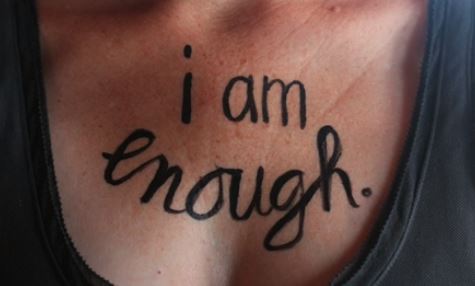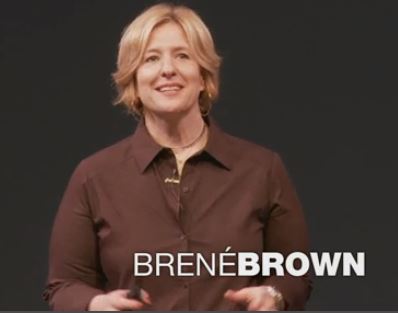TEDTalk Countdown: the #3 most-watched video on TED.
The Big Idea: To be fully alive is to be vulnerable. Embrace vulnerability.
The overall construct of the speech: A somewhat chronological retelling of events leading to insight.
Not perfect:
Honestly, I was so engaged by this talk that I found it difficult to find fault. The number one thing I noticed was that the opening, although highly engaging was a bit meandering. She didn’t clearly state a main point, but did intrigue me with this statement, transitioning from her first story:
“I want to talk to you and tell you some stories about a piece of my research that fundamentally expanded my perception and really actually changed the way that I live and love and work and parent.”
Timing of some of her PowerPoint slides. For example, she displayed the slide below while saying “and lay the code out for everyone to see. So, where I started was with connection . . .”
Actually, the slide may have been displayed even earlier, but on the video, that is when it was displayed. Showing this slide while she was saying “and lay the code out for everyone to see” created a distraction as it didn’t match what she was saying. What would have been better would have been for her to pause after saying “and lay the code out for everyone to see.” (Pause) Display the slide (Pause) and then say, “So, where I started was with connection . . .”
What she nailed:
Highly engaging style: She seemed very relaxed, yet animated. She had a friendly demeanor, with a conversational tone, open body language, frequent smiling. In the first minute and a half of her talk, she was smiling for about 1 minute of that time (she was telling a story and the only time she wasn’t smiling was when she was saying dialogue of another person).
Use of common, authentic language:
(at first meeting with therapist) “And I think I have a problem, and I need some help.” And I said, “But here’s the thing: no family stuff, no childhood shit.” (Laughter) “I just need some strategies.”(Laughter) (Applause) Thank you. So she goes like this. (Laughter) And then I said, “It’s bad, right?” And she said, “It’s neither good nor bad.” (Laughter) “It just is what it is.” And I said, “Oh my God, this is going to suck.”
Being vulnerable: She practiced what she preached when she talked about having a breakdown and seeing a therapist.
Use of stories: She opened with a story and had a few more stories woven into her talk.
Story 1: (opening) Story of meeting planner not wanting to call her a researcher
Story 2: Story of her as a young researcher
Story 3: Story of her research (extended)
Story 4: Story of her seeing a therapist
Use of humor:
She got her first laugh in fewer than 30 seconds into her talk. And she got her second only about 20 seconds after that. She had several instances of humor throughout the talk. The audience laughed about 20 times during her 20 minute talk. Not bad for a talk on a serious subject!
Here is part of her opening story, showing where she got her first two laughs:
So, I’ll start with this: a couple years ago, an event planner called me because I was going to do a speaking event. And she called, and she said, “I’m really struggling with how to write about you on the little flier.” And I thought, “Well, what’s the struggle?” And she said, “Well, I saw you speak, and I’m going to call you a researcher, I think, but I’m afraid if I call you a researcher, no one will come, because they’ll think you’re boring and irrelevant.” (Laughter)And I was like, “Okay.” And she said, “But the thing I liked about your talk is you’re a storyteller. So I think what I’ll do is just call you a storyteller.” And of course, the academic, insecure part of me was like, “You’re going to call me a what?” And she said, “I’m going to call you a storyteller.” And I was like, “Why not magic pixie?” (Laughter).
Her humor was not only what she said, but how she said it, with facial expressions, gestures and tone of voice which showed her reactions to situations.
The basis of her humor was largely self-deprecation, one of the “safest” forms of humor.
Use of highly quotable phrases:
“Stories are just data with a soul.”
“Life’s messy, clean it up, organize it and put it into a bento box.” The unusual use of “bento box” is what made this memorable for me. As an aside, if you don’t know what a bento box is, it’s a divided meal box, common in Japanese cuisine. Even if you didn’t know what a bento box meant, you would understand from the context that she meant she liked to contain the mess of life.
“They believed that what made them vulnerable made them beautiful.”
“BS Meter”
“You cannot selectively numb.”
“I’m enough.”
Interpretation of original research: She wasn’t referencing someone else’s material. She spent years researching the topic.
Memorable visual: The one at the very top, “You are enough” is stuck in my brain
The Big Take Away: Be real. Be vulnerable. Connect.



